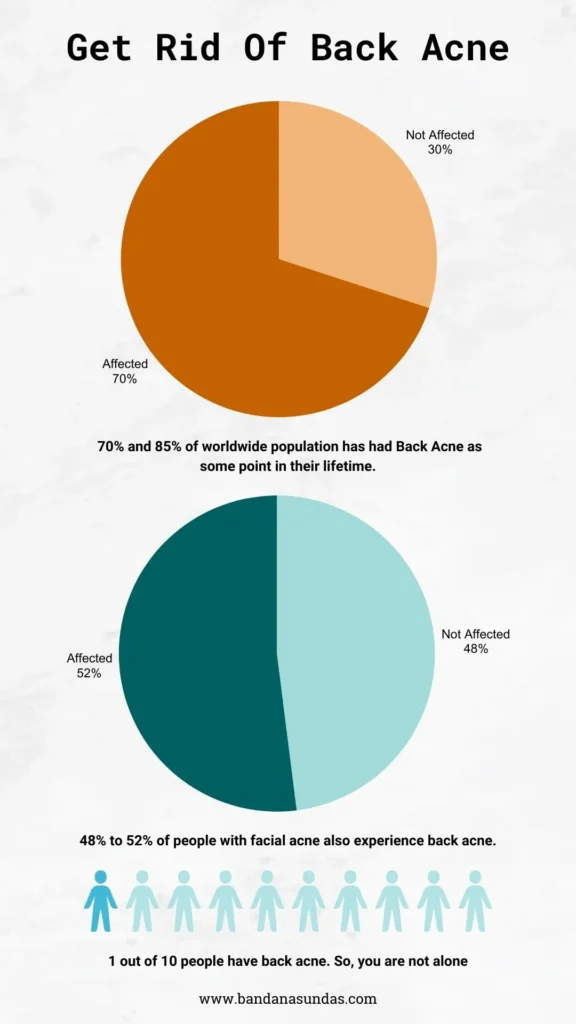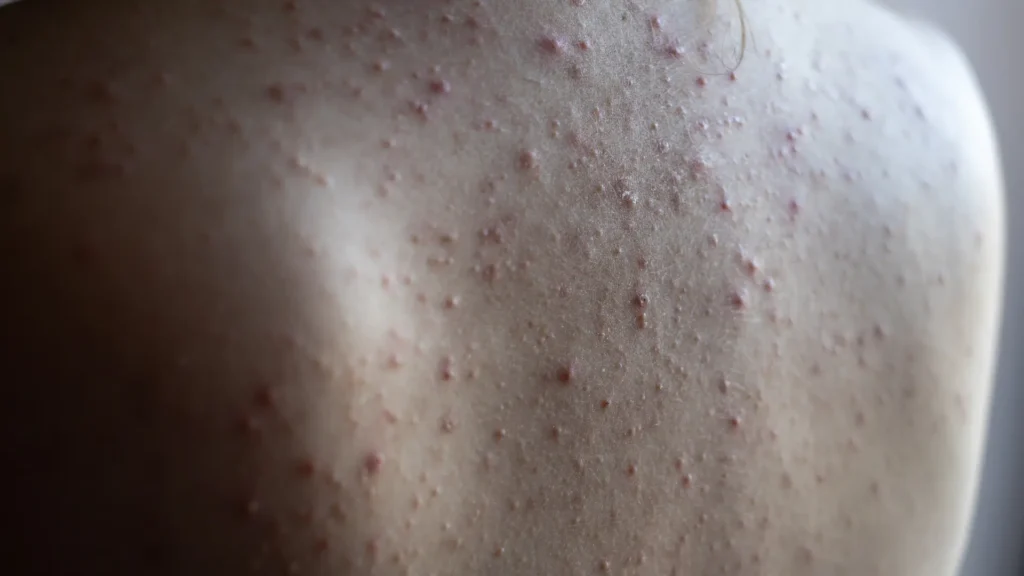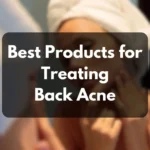Back acne, commonly known as “bacne,” is a pesky condition many of us have faced. If you’ve been battling with it, you’re not alone. From clogged pores to excess oil and sweat, back acne can have a variety of causes.
But there are effective home remedies for back acne that can help you get rid of it right from the comfort of your own home.
In this blog, we’ll explore the most effective remedies, lifestyle changes, and skincare tips to help you achieve clear, confident skin. Plus, I’ll share my personal experience of overcoming back acne after nearly a decade of frustration.
Subscribe to our newsletter. No spam. Unsubscribe anytime.
Follow Us on Pinterest
Disclaimer: Some of the links in this article are affiliate links, which means I may earn a small commission if you make a purchase through them, at no additional cost to you. As an Amazon Associate, I earn from qualifying purchases. I only recommend products I trust and believe will provide value to my readers.
Understanding Back and Shoulder Acne
Back acne is much like facial acne—it forms when hair follicles on your back and shoulders become clogged with excess oil (sebum), dead skin cells, and bacteria.
These clogged pores can lead to inflammation, causing pimples, cysts, and other blemishes to form.
Bacne is particularly common among teenagers and young adults due to hormonal changes that increase oil production, but it can persist into adulthood due to lifestyle factors or underlying health conditions.
Here is the factual data listed from the provided excerpt:

- Truncal acne (back acne) affects the pilosebaceous unit.
- Global lifetime prevalence is between 70% and 85%.
- About 48% to 52% of people with facial acne also experience back acne.
- Men are slightly more affected than women.
- Common characteristics include noninflammatory comedones, inflammatory pustules, papules, and nodules.
- The most affected areas include the upper back, followed by the upper chest, lower back, shoulders, extremities, and neck.
- Back acne affects about 9.4% of the global population, ranking it among the top 10 prevalent diseases worldwide.
Source: Dermatology Times.
Simply saying that 1 0ut of 10 people have back acne, so you are not alone.
Causes of Bacne
Hormonal Changes
Hormonal fluctuations, particularly during puberty, lead to an increase in sebum production. This excess oil clogs pores, making back acne common in adolescents.
Back Acne Due To Sweating
Sweating can create an ideal environment for bacteria to thrive. Combined with friction from tight clothing, sweat can clog pores and lead to breakouts.
Bacne from Tight Clothing
Tight or non-breathable fabrics like synthetic gym wear can trap sweat and bacteria against your skin, further aggravating bacne.
Poor Hygiene
Infrequent showering, especially after physical activities, can allow sweat, dirt, and oils to accumulate on the skin, leading to acne formation.
Diet and Supplements
As I learned from personal experience (which I’ll share later), certain diet changes, like weight-gain supplements or consuming unhealthy foods, can also contribute to back acne by disrupting your hormones.
A Personal Journey with Back Acne
I first noticed my back acne in 2011 when I was 16. I assumed it was just an odd breakout that would disappear once my teenage years were over.
But as time passed, the acne spread to my shoulders, and I became more and more self-conscious. I started avoiding tank tops and even missed gym and swimming sessions with friends out of embarrassment.
Years later, during the pandemic, I finally had a breakthrough. I stumbled upon a YouTube video where a gym instructor explained how a client’s use of a cheap weight gainer led to back acne.
That’s when it clicked—I had taken a similar health drink back in 2011! This realization finally gave me peace, and after nine long years, I decided to tackle the issue head-on.
Now, I’m sharing the tips and tricks that worked for me, so you can finally say goodbye to back acne too.
Before and After: My Back Acne
At the time, I had no idea I would eventually write a blog about my back acne experience, so I don’t have photos of my own early breakouts. However, here’s an image that closely resembles what my back acne looked like at its worst:

And here’s what my back looks like now. While I still have some scars, they have gradually lightened over time without any specific scar treatment:

The transformation wasn’t overnight, but with consistent care and lifestyle changes, I’ve seen major improvements in both my acne and the appearance of my skin!
Best Home Remedies For Back Acne I Followed
1. Tea Tree Oil and Apple Cider Vinegar Solution
Tea tree oil is known for its antibacterial properties, which help fight acne-causing bacteria.
Apple cider vinegar (ACV) is great for balancing the skin’s pH and preventing breakouts.
I found it helpful, though I wasn’t a fan of the smell. Mix one tablespoon of ACV with water and a few drops of tea tree oil, then gently apply it to your back with cotton.
You might love it more than I did!
2. Aloe Vera Gel
Aloe vera is soothing, healing, and perfect for reducing acne inflammation.
I used fresh aloe vera gel mixed with granulated salt, applied it directly to my back, and let it dry for about two hours before showering. This not only helped with the acne but also kept my skin hydrated and smooth.
Lifestyle Changes to Prevent Back Acne ( My 6 Golden Rule)
Making small lifestyle adjustments can go a long way in preventing future breakouts. Here’s what worked for me:
1. Wear Breathable Fabrics
Switch to loose-fitting, airy clothes, especially at home. Tight clothing can trap sweat and oil, worsening acne. I started wearing tank tops again, and it made a noticeable difference!
Also, avoid any items that may cause friction on your back or shoulders, such as backpacks or bag straps, as they can aggravate acne and delay healing.
2. Shower Daily (Especially After Sweating)
Take a shower every day, especially after working out or sweating.
I made sure to shampoo and condition my hair first so any residue wouldn’t linger on my back.
Use a body wash for acne-prone skin, like one containing salicylic acid or benzoyl peroxide.
Proper cleansing is key!
3. Exfoliate (But Not Too Much!)
Exfoliating is key to removing dead skin cells that clog pores, but overdoing it can irritate the skin.
I used Neutrogena Body Clear Oil Body Wash with Salicylic Acid, proven acne-fighting ingredient to help treat present breakouts and prevent future body acne. Back then it was not availabe in my country so i had to pay double in customs and delivery charges just to get it this product.
I also avoided harsh scrubbing tools that could aggravate the skin.

4. Change Sheets Weekly
Your bed sheets and pillowcases can harbor bacteria and oils, which transfer to your skin. Changing them weekly helped me keep breakouts at bay.
5. Eat Clean, Stay Hydrated
Avoid oily foods, and try incorporating low-fat yogurt into your diet to keep your gut healthy. Staying hydrated flushes out toxins and keeps your skin clear.
6. Manage Stress
Stress can cause hormonal fluctuations, leading to more breakouts. I found that meditation and light exercise helped me manage my stress levels, which in turn improved my skin.
What to Avoid When Treating Back Acne
Sometimes, less is more when it comes to skincare. Here are a few things to steer clear of:
- Don’t Scratch or Pop Pimples: As tempting as it might be, scratching or popping your acne will only make it worse and may lead to scarring. I did this mistake and I regret it.
- Avoid Over-Exfoliating: Stick to gentle exfoliation. Harsh scrubs or frequent exfoliation can irritate your skin and cause more breakouts.
My Timeline for Clearer Skin
I began seeing noticeable results within the first two to three months of following my new routine. My acne gradually started decreasing, and by sticking to this lifestyle, I saw continuous improvement.
After two years, I was able to stop applying the remedies altogether in 2022 because I no longer needed them.
Interestingly, I didn’t take any specific steps to treat my scars since they didn’t bother me. To my surprise, the scars have been fading naturally over time.
I still follow the lifestyle till today except for applying the home remedies.
Do I Still Get Back Acne?
Yes, I do still get the occasional breakout, but it’s nowhere near as severe as it used to be. These new spots tend to heal on their own within a week or two, thanks to the consistent lifestyle changes I’ve made.
My skin now manages itself much better, and the breakouts are far less frequent and intense than before.
Quick recap: Changes I made to my lifestyle in short and skincare routine.
- Loose clothing: Wearing airy fabrics like tank tops helped keep my skin dry.
- Daily showers: I started showering every day and made sure to shampoo and condition my hair first, washing my body afterward to rinse away any residue.
- Neutrogena Acne Body Wash: This body wash helped exfoliate and keep my back dry, which was crucial for clearing up my acne.
- Apple Cider Vinegar and Tea Tree Oil: Mixing these two with water helped, though I didn’t stick with it due to the smell.
- Aloe Vera: I applied raw aloe vera before my showers, which helped calm my skin and reduce scars.
- Diet: I avoided oily foods and ate low-fat yogurt every night to keep my gut healthy.
Identifying Your Skin Type: Why It Matters
The first step in treating back acne is to understand your skin type. Knowing your skin type helps you select the right treatments, preventing flare-ups and improving results.
- Oily Skin: Produces excess oil, making you more prone to clogged pores.
- Dry Skin: Lacks moisture, which can mask acne but still lead to breakouts from irritation.
- Combination Skin: Experiences oily areas in some places (like the back) and dry patches in others.
- Normal Skin: Balanced but may still experience occasional breakouts.
Why this matters: Tailoring your acne treatment to your skin type will increase your chances of success. For oily skin, products that reduce sebum production are crucial, while for dry skin, gentler treatments that prevent irritation are necessary.
PS Quick Read: Ultimate Guide to Oily Skin Prevention
Proper Hygiene: The First Line of Defense
Maintaining good hygiene is essential in keeping your back and shoulders acne-free. Since bacne is often exacerbated by factors like sweat and dirt, proper cleansing techniques can make a world of difference.
- Daily Showers
Take a shower at least once a day, especially after physical activities that cause sweating. Focus on cleansing your back and shoulders to remove any impurities. For individuals with oily or acne-prone skin, using a body wash containing salicylic acid or benzoyl peroxide can help unclog pores and fight acne-causing bacteria. - Exfoliation
Regularly exfoliating your back can prevent dead skin cells from clogging your pores. Use a gentle exfoliating scrub 1-2 times per week, being careful not to overdo it, as over-exfoliation can strip the skin of its natural oils and worsen acne. - Moisturize Your Skin
Even acne-prone skin needs hydration. Opt for a lightweight, non-comedogenic moisturizer that won’t clog pores but will keep your skin balanced and healthy.
Pro Tip: When washing your hair in the shower, shampoo and condition your hair first. This prevents hair product residue from sitting on your back and potentially clogging pores.
Natural Ingredients for Treating Back Acne
There are several natural remedies known for their acne-fighting properties. Here’s a breakdown of the most effective ones:
Tea Tree Oil
Tea tree oil is well-known for its antibacterial and anti-inflammatory properties. You can apply it to the affected area, but remember to dilute it with a carrier oil like coconut or jojoba oil to avoid skin irritation.

Aloe Vera
Aloe vera is soothing, healing, and hydrating, making it an excellent remedy for calming inflamed acne. Apply fresh aloe vera gel directly to your back and let it absorb. Read more about it in this article.

Apple Cider Vinegar
Apple Cider Vinegar acts as an astringent, balancing your skin’s pH and helping to reduce acne-causing bacteria. Mix it with water and apply with a cotton pad to your back as a toner. However, the smell can be off-putting, so feel free to skip it if that’s a concern!
Home Remedies and DIY Treatments
If you prefer a natural approach to treating your acne, here are a few home remedies you can try:
- DIY Exfoliating Scrub
Mix equal parts of sea salt or sugar with coconut oil to create a scrub. The exfoliating granules will help remove dead skin cells, while the coconut oil provides hydration. - Oatmeal Mask
Oatmeal is great for soothing irritated skin. Blend oats into a powder, add water to form a paste, and apply to the acne-affected areas for 20 minutes before rinsing off. - Honey Spot Treatment
Honey has natural antibacterial properties. You can apply raw honey directly to acne spots for at least 30 minutes before rinsing off.
Lifestyle Changes for Preventing Back Acne
While hygiene and skincare products can do wonders for treating back acne, sometimes lifestyle changes are necessary for preventing future breakouts.
- Wear Loose, Breathable Clothing
Tight, synthetic fabrics can trap sweat and bacteria against your skin, exacerbating acne. Opt for breathable materials like cotton, especially when working out. - Stay Hydrated and Eat Clean
Drinking plenty of water flushes toxins out of your body and keeps your skin healthy. A balanced diet rich in fruits, vegetables, and omega-3s can reduce inflammation and prevent breakouts. Avoid sugary, processed, and oily foods. - Manage Stress
Stress can cause hormonal fluctuations that lead to breakouts. Engage in stress-relieving activities like meditation, yoga, or deep breathing exercises to keep your skin clear.
When to Seek Professional Help
Sometimes despite your best efforts, back acne may persist.
If you experience painful or cystic acne on your back, it’s time to seek professional help.
Dermatologists can offer prescription treatments for back acne that may include topical or oral medications.
A dermatologist can help you with:
- Prescription-strength topical or oral treatments
- Chemical peels or light therapy
- Corticosteroid injections for cystic acne
- Recommendations for diet and lifestyle adjustments
The Path to Clear, Healthy Skin
Back acne can be stubborn, but with consistent effort and the right back acne skincare routine, it’s possible to achieve clear, healthy skin. Stick to a combination of natural remedies for back acne and lifestyle changes, and you’ll likely see results. Remember, your journey may take time, but with persistence, you can overcome back acne and regain your confidence. Keep your skin clean, hydrated, and healthy, and don’t hesitate to seek professional help if needed.
PS Quick Read: Ultimate Guide to Oily Skin Prevention
Follow Us on Pinterest
Medical Disclaimer:
Medical Disclaimer: The information provided in this article is for educational purposes only and is not intended as a substitute for professional medical advice, diagnosis, or treatment. Always seek the guidance of a qualified healthcare provider with any questions you may have regarding a medical condition. If you have persistent or severe acne, or if over-the-counter remedies do not improve your condition, consult a dermatologist for personalized treatment.






Pingback: Best Products for Treating Back Acne: What Really Works? - Radiant Lifestyle By Bandana
Pingback: How to Prevent Back Acne: 6 Simple Lifestyle Changes You Need
Pingback: Dealing with Acne Scars: How to Fade Bacne Marks Naturally - Radiant Lifestyle By Bandana